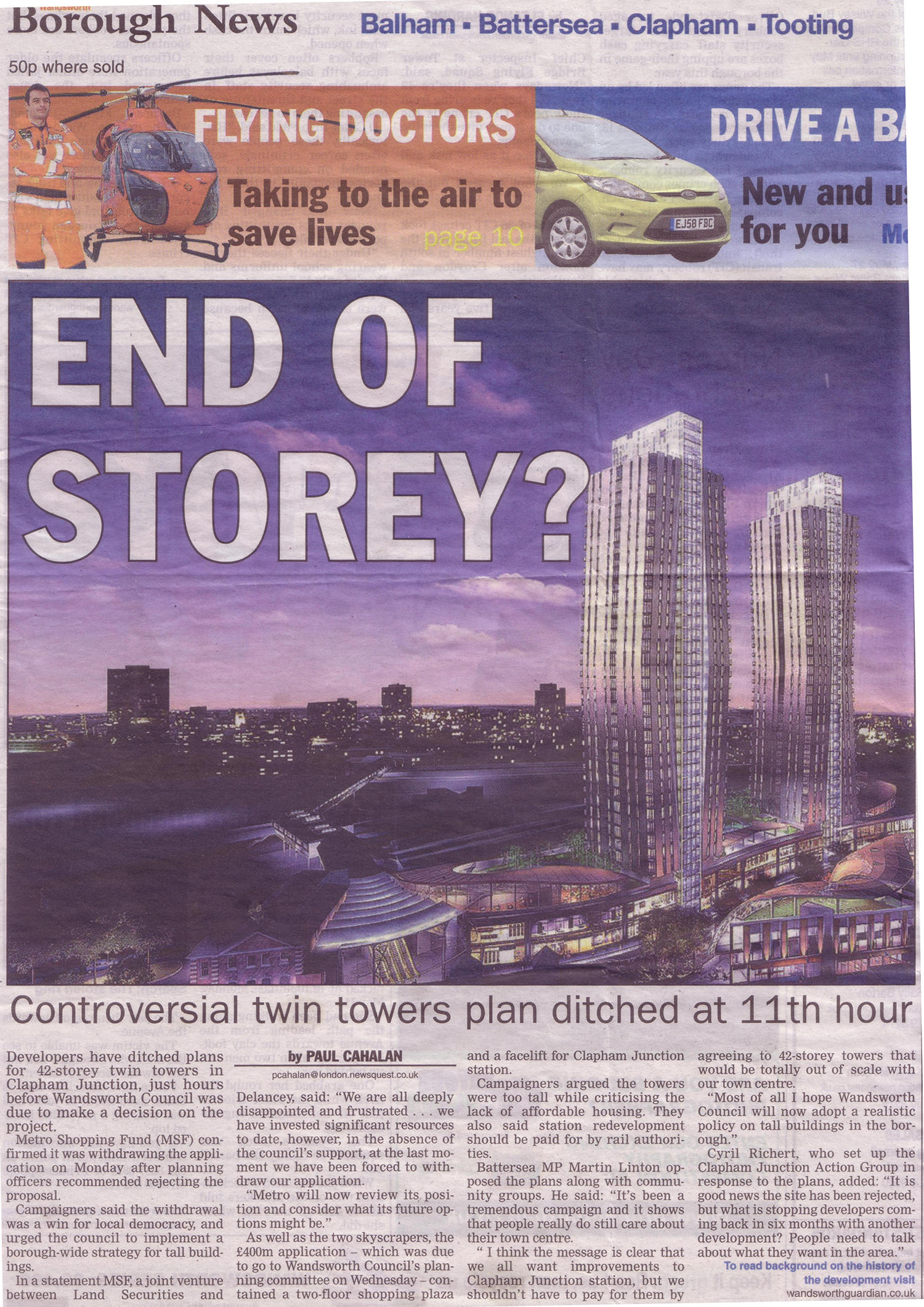One of our primary aims has been to ensure that a proper consultation takes place in which the views of local residents are actively encouraged. As a result, the Council has agreed to consider any representations made to it before the Planning Committee meeting decides the proposal some time in February (date to be announced).
The following exchange took place on 5th December 2008 between the Council’s planning officer (CPO in blue-italic), and Kate Williams of our Action Group (KW responses in bold). In fairness to the Council, we undertake to publish the Council’s response in full.
CPO “With regard to your letter of objection sent by e-mail on 4th November, you raised a number of points to which I have not responded. Unfortunately, given the large number of points raised in letters, it is not possible with such an application to write in response to each one, however, I intend to write a full and frank report to Committee, which should therein, respond to points raised in correspondence, as well as taking into account all other material considerations.
This is a very complex planning application, with many interlinked issues. However, to provide some response to the points you raise;
As you point out, the accommodation in the proposed development is predominantly one and two bedroom flats, and the target would not therefore be families, however, it must be considered if this specific location is one that is suitable for families. In locations where developments are more suitable for families, Officer’s would certainly look for developments to provide a greater proportion of family housing. The noise attenuation of the development has been assessed in relation to Planning Policy Guidance 24 ‘Noise,’ which gives stringent guidance which would need to be met in relation to the provision of residential properties adjacent to noisy uses. Your assessment of the residential use in tall buildings appears somewhat bleak when you refer to ‘no-go zones’, I would point to examples such as the Barbican Towers, the Trellick Tower, and many such examples in the Docklands, where high rise living is popular and works well, and are not ‘hotbeds of crime and anti-social behaviour.’ “
KW: “My point relating to tower blocks is that these are not, generally, regarded as desirable places to live and I wonder what measures the Council is taking to ensure that the entire development does not end up as a ‘white elephant’ unable to attract any of the residents that the developers seem to be so confident of enticing. Indeed, the Trellick tower that you compare the development to started life with a very poor reputation for crime and anti social behaviour. This led to security measures being taken in the late 70s and to the Tower only emerging as a desirable place to live in the 1980s, largely due to the reputation of its brutalist architect Erno Goldfinger. My concern is that in an economic climate not dissimilar to the 1970s, no-one will choose to live in high rise flats above Clapham Junction station and measures may need to be taken to fill the apartments with the types of resident who made Trellick Tower such an undesirable place. Indeed, with most of the latest river developments still unoccupied, I am concerned that this outcome is almost guaranteed.
Whilst the comparison to Trellick Tower is apt, the comparisons to the Barbican and Canary Wharf are not. These are areas of intense high rise development and their effect has been to displace the local communities entirely in favour of executives and wealthy retirees. I am no more keen on having executive islands in the vicinity than on creating an inner city nightmare. Our community has one of the best mixes of class, occupation and age that I have encountered anywhere in London . If anything, what we need is more affordable housing for families, and it is this that the Council should strive to achieve.”
CPO: “With regard to the relocated station entrance, the main solution proposed to station congestion and overcrowding is to provide new entrance buildings to the station via escalators and lifts to the existing over bridge, (which is two and a half times the width of the subway). This approach allows the existing subway to be used for interchange between trains only, relieving the worst points of congestion, and spreads passengers along the platforms, the principle of which was devised by passenger flow modelling work undertaken by Network Rail and Transport for London. This approach would also have the benefit of providing for disabled/pushchair access via lifts from the entrance buildings to the bridge, as well as direct level access from Brighton Buildings to the bridge, with a dedicated disabled drop-off/pick up point in Brighton Yard. This would link with the DfT Access for All proposals to include lifts from the overbridge to platforms 1-16. The approach allows for increased capacity and facilities for ticketing and train information and, although a slightly further distance to walk for some people, the comfort of the passenger experience should be enhanced. The passenger flow modelling work by TfL and Network Rail indicates that allowing for access and egress points from the existing tunnel as well as the over bridge would quickly lead to a return to congestion. Further congestion also occurs at present at the station/shopping mall exit to St John’s Hill, where people exiting the station and those waiting for buses converge. The current proposals would create an enhanced public realm, allowing better dispersal of passengers through the improved permeability of the site, re-siting of bus stops and taxi rank and improved and expanded cycle parking facilities. The proposals have been designed to integrate with the Councils proposed Exemplar scheme for improvements to traffic flow, public realm and pedestrian facilities in the immediate vicinity. The proposal also includes the applicants giving land to Network Rail adjacent to platform 17 to allow for the straightening of platforms 15-17 and the removal of the existing gaps between platforms and trains, and would allow for Network rail to potentially lengthen platforms and allow longer trains to operate.“
KW: “Regarding the station development, it is a pity that this has been the subject of much mis-information which I have taken some trouble since first writing to investigate. I am not at all opposed to the development of the station nor to the entrance reverting to the Brighton Buildings where it was originally. I understand, however, that the majority of the actual improvement work will be carried out by Network Rail including platform straightening and the provision of lifts and stairs to platforms. As far as I can see, this leaves only the provision of new entrances and escalators to be carried out by the developers, whereas in many documents I have seen (including the Mayor’s consultation report) they appear to take credit for the entire scheme. The provision of new entrance buildings (when one of these already exists) seems to be a very poor deal for the people of Clapham Junction opposed to the towers, and does little to make up for the lack of any affordable housing within the scheme. Indeed, much of the purpose of these entrances appears to be to create new retail space, and costs could surely be saved by Network Rail providing straightforward station facilities in place of the proposed commercial uses?”
CPO: “With regard to the position of Network Rail funding, they state that ‘funding for improvements to the Station (other than for lift access from the over bridge to platforms already identified) is not identified in the current or next funding periods The earliest funding could come forward is in the period 2014 to 2019, but would require support from the Government and Office of Rail Regulation, and there is no certainty on funding nor what the competing priorities would be at that time.’ “
KW: “In my original e-mail, I asked for clarification as to the steps that the Council has taken to hold Network Rail to its current commitment (as set out in its Strategic Plan 2006-14) to carry out the whole of the scheme itself. What justification does Network Rail give for now reneging on this promise, and what benefits is it hoping to realise through the disposal of lands associated with the development? There appear to be some very difficult questions which need to be asked, and the Councillors need to be absolutely satisfied that the necessary linkage of the proposed development to the station upgrade has been adequately demonstrated. In many people’s minds this issue is key as almost all agree that the station is woefully inadequate at present. I should very much appreciate your detailed response on this issue since I have no wish to misinform others in our campaign against this development. Copies of any correspondence or minutes of meetings in which Network Rail has been asked to respond on these issues would be greatly appreciated.”
CPO: “One further point I would like to clarify was raised at the Northcote Ward meeting, and which has been the subject of some misinformation, is the issue of relating the height of the proposal to Tower 42 (formerly the Nat West Tower ). Whilst both would indeed have 42 floors, Office buildings are however constructed approximately 1 metre per floor larger than residential buildings. Tower 42 has a height 183m, whereas the proposal for Clapham Junction would be 142m. “
KW: “I have been very careful always to point out that the proposed towers have the same number of floors as the Nat West Tower, and have never claimed that they are the same height. Indeed, since their height was not mentioned in the Planning Consultation leaflet, I only recently learned that the Clapham Junction development will reach as high as 142 metres, sufficient for the Aviation Authority to require aircraft warning lights! Indeed, if there has been any misinformation then, with respect, it comes from the omission of this information from the Council’s Planning Consultation Document, and by the display of pictures which cut the towers off at their bases. In my original e-mail, I asked for scale models to be provided at the station. If people are to be properly informed as to the height of these towers, then it is of very great importance that this should be done. I have no doubt that the developers are able to provide such models, or at the very least publicity posters displaying their full height. I shall continue campaigning for this and hope very much that the Council considers this part of its duty to inform.”
We do very much appreciate that the Council has much to do and that our requests create additional work. However, this is a proposal which has very significant implications for the entire borough and, whether people are for or against it, it is of paramount importance that they should be properly informed.















Additional to all the other good reasons for not trading towers for improvements, I know it is kind of spooky to mention terrorism, but we are talking about twin towers 42 storeys high over the biggest junction in Europe. I think it is madness to think about it even on these grounds alone. What a target!
Already Clapham Junction is under-policed, what will they do about the increased attractiveness of a possible target…who will pay for additional security?
And where are the people from the 500 flats going to park…and what consideration has been given to the conflict of interest regarding the building of a Polyclinic in the same area?
Also, the document from Mark Hunter refers to the absence of suitable premises (as those that would be created at the new CJ) having put pressure on Northcote Road where large businesses have moved in replacing independents. This is not correct. Northcote Road was voted the 2nd most popular Road in London, and as in Portobello Road, chain stores have moved in with the expectation of making a killing…and indeed have done just that! They are killing the goose that laid the golden egg.